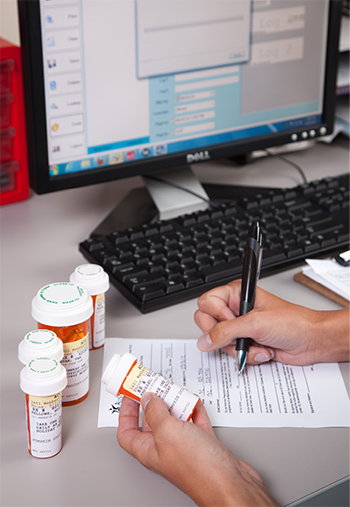4.2 Essential Knowledge for Technicians
When a pharmacy technician enters a prescription into the computer or pulls a drug from stock, it helps to be familiar with both the brand and generic names and their common dosage forms. Many names, dosages, and formulations are very similar and confusing if one doesn’t have a basic understanding of pharmacology.
Without any familiarity, dangerous medication errors can occur. In many cases, prescribers write a prescription for a brand name drug—which is often easier to remember and spell—though a generic drug will be dispensed. So the pharmacy technician must be aware of the correct substitutions and situations when generic drugs can be legally substituted for brand name drugs and when they cannot.
 Safety Alert
Safety Alert
Some drugs at higher doses can have a paradoxical effect. This may be a pain medication causing pain or an antidepressant causing suicidal panic. Prescribers, pharmacists, and technicians must ask about and be on the alert for any mention from patients about these kinds of dangerous side effects.
Besides recognizing common drugs and their generic substitutions, technicians should know the primary indications for the drugs, or the common intended uses, to treat specific diseases. For instance, a patient may call in to request a refill on their blood pressure medication, but they cannot remember, spell, or even pronounce the drug name correctly and do not have the prescription number readily available. How will the pharmacy technician know which medication in the patient’s profile to refill without a basic knowledge of the indications of various drugs?
Technicians and pharmacists must also be aware of the contraindications of each drug—the specific situations in which a drug should not be used because it will be harmful to a patient. Say that same patient comes in for a refill, and the patient’s medication history says that a new prescription for Nitrobid (nitroglycerin) has been added to the patient’s record since the last refill. The contraindication for the antihypertensive drug refill says that it should not be given to patients who are taking nitroglycerin. The technician, seeing this, must then query the pharmacist and perhaps even the provider or provider’s nursing assistant to see what should be done.
Additionally, one has to remember that, for every intended drug action, there are related unintended reactions, or side effects, that must always be considered. They can be mild or severe, such as varying intensities of nausea, constipation, diarrhea, itchiness and other skin reactions, drowsiness, pain, muscle aches, headaches, shakiness, and numbness. Though less common, technicians should also be aware of paradoxical drug reactions or effects. A paradoxical drug reaction occurs when use of a medication has the opposite effect from what is normally expected.
Drug interactions occur when a drug affects the intended indication of another medication or reacts poorly with it. Interactions can happen between a drug and another prescribed (or nonprescribed) drug, food, or multiple drugs. Drugs in combination can cause many difficulties as they react together, and their side effects build up. In some cases patients are on multiple medications for chronic conditions and suffer from the side effects of drug. When one or more of the interacting drugs are discontinued, these patients find that their symptoms and overall health improve, in some cases dramatically. A drug can also interact badly with over-the-counter (OTC) and homeopathic drugs. Even vitamin, nutrient, or herbal supplements can interfere with or enhance the potency of a drug, or cause intense reactions; so the vitamins and supplements a patient is taking must be added to the patient profile and also considered. Finally, a drug to address one disease might worsen another disease or condition the patient is experiencing.
Adverse drug events (ADEs) are injuries or harmful responses due to the use of a drug. ADEs can arise from side effects, contraindications, allergic reactions, wrong use, or the results of combining a drug with one or more other medications, vitamins, or herbal supplements. ADEs account for approximately 125,000 hospital admissions each year, according to statistics from the US Department of Health and Human Services in 2014. These events can range in severity from an extremely unpleasant experience of shaking, vomiting, hives, and other occurrences, to paralysis, blindness, and death.

Technicians need to read prescriptions and medication profiles very carefully for each small detail—spelling dosages, indications, contraindications, potential interactions, and side effects. If something is amiss, they must question the pharmacist and, at times, the provider or assisting nurse.
That is why technicians must look so carefully at the patient profile of medications, allergies, history of use, and software alerts. The pharmacist watches most specifically for these things and makes the final decisions, but the technician serves as the first line of inquiry and defense against prescription errors. This is why knowing more about common drugs and their indications and contraindications is important for pharmacy technicians.